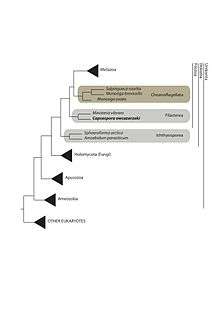Capsaspora
| Capsaspora | |
|---|---|
 | |
| Scientific classification | |
| Domain: | Eukaryota |
| (unranked): | Opisthokonta |
| Class: | Filasterea |
| Genus: | Capsaspora Hertel, Bayne & Loker, 2002[1] |
| Species: | C. owczarzaki |
| Binomial name | |
| Capsaspora owczarzaki Hertel, Bayne & Loker, 2002[1] | |
Capsaspora is a monotypic genus containing the single species Capsaspora owczarzaki, a single-celled eukaryote which is a symbiont in the haemolymph of the tropical freshwater snail Biomphalaria glabrata.[1] The genome of C. owczarzaki has been sequenced.[2]
Description
C. owczarzaki cells were described as 3 to 5 μm amoebas with a nucleus ⅓ - ½ of the diameter of the cell (containing a central nucleolus), long unbranched pseudopodia, mitochondria with flattened cristae, numerous phagosomes, lipid vacuoles, glycogen granules and a Golgi apparatus.[3][4] Cells could encyst in response to crowding, generating 4 to 5 μm cysts with a double wall: the outer thin, irregular and loosely attached; and the inner thicker, smooth.[5]
Taxonomy
C. owczarzaki is together with Ministeria vibrans a member of the Filasterea clade.[6][7] This group is probably the sister group to a clade comprising Metazoa and Choanoflagellata, which together form the Filozoa [6][7][8] (See Figure 1).

Applications
C. owczarzaki is of scientific interest because it is one of the closest unicellular relatives of multicellular animals. Its genome has recently been sequenced and shows several genes involved in metazoan multicellularity, such as integrins,[9] metazoan transcription factors,[10] and protein tyrosine kinases.[11] Moreover, it has relevance to human health because its host, the snail Biomphalaria glabrata, is also the intermediate host of the digenean flatworm Schistosoma mansoni, the causative agent of widespread schistosomiasis in humans. C. owczarzaki not only parasitizes the intermediate host of S. mansoni but also attacks and kills the sporocysts of the flatworm living inside the snail.[4]
References
- 1 2 3 Hertel L. A.; Bayne C. J.; Loker, E. S. (August 2002), "The symbiont Capsaspora owczarzaki, nov. gen. nov. sp., isolated from three strains of the pulmonate snail Biomphalaria glabrata is related to members of the Mesomycetozoea", International Journal for Parasitology, 32 (9): 1183, doi:10.1016/S0020-7519(02)00066-8, PMID 12117501
- ↑ http://www.broadinstitute.org/annotation/genome/multicellularity_project/MultiHome.html
- ↑ Stibbs, HH; Owczarzak, A; Bayne, CJ; DeWan, P (March 1979). "Schistosomesporocyst-killing amoebae isolated from Biomphalaria glabrata". J Invertebr Pathol. 33 (2): 159–70. doi:10.1016/0022-2011(79)90149-6.
- 1 2 Owczarzak, A; Stibbs, HH; Bayne, CJ (January 1980). "The destruction of Schistosoma mansoni mother sporocystsin vitro by amoebae isolated from Biomphalaria glabrata: an ultrastructuralstudy". J. Invertebr. Pathol. 35: 26–33. doi:10.1016/0022-2011(80)90079-8.
- ↑ Sebe-PedrosA. 2013. The origin of metazoan multicellularity, a genomic and functionalapproach. PhD UB, Facultat de Biologia, Departament de Genètica
- 1 2 Torruella, G; Derelle, R; Paps, J; Lang, F; Roger, A; Shalchian-Tabrizi, K; Ruiz-Trillo, I (2012). "Phylogenetic relationships within theOpisthokonta based on phylogenomic analyses of conserved single copy proteindomains". Molecular Biology and Evolution. 29 (2): 531–544. doi:10.1093/molbev/msr185.
- 1 2 Shalchian-Tabrizi, K; Minge, MA; Espelund, M; Orr, R; Ruden, T; Jakobsen, KS; Cavalier-Smith, T (2008). "Multigene phylogeny of choanozoa and the origin of animals". PLOS ONE. 3 (5): e2098. doi:10.1371/journal.pone.0002098. PMC 2346548
 . PMID 18461162.
. PMID 18461162. - ↑ Paps, J; Medina-Chacon, L; Marshall, W; Suga, H; Ruiz-Trillo, I (2013). "Molecular phylogeny of Unikonts: new insightsinto the position of apusomonads and ancyromonads and the internalrelationships of opisthokonts". Protist. 164 (1): 2–12. doi:10.1016/j.protis.2012.09.002.
- ↑ Sebe-Pedros, A; RogerA, Lang F; King, N; Ruiz-Trillo, I (2010). "Ancient origin of integrin-mediated adhesion and signaling machinery". Proceedings of the National Academy of Sciences USA. 107 (22): 10142–7. doi:10.1073/pnas.1002257107.
- ↑ Sebe-Pedros, A; de Mendoza, A; Lang, F; Degnan, B; Ruiz-Trillo, I (2011). "Unexpected repertoire of metazoan transcription factors in the unicellular holozoan Capsaspora owczarzaki". Molecular Biology and Evolution. 28 (3): 1241–54. doi:10.1093/molbev/msq309.
- ↑ Suga H, DacreM, de Mendoza A,Shalchian-Tabrizi K, Manning G, Ruiz-TrilloI. (2012) Genomic Survey of Premetazoans Shows Deep Conservation of Cytoplasmic Tyrosine Kinases and Multiple Radiations of Receptor Tyrosine Kinases. Science Signaling 5(222),ra35 doi:10.1126/scisignal.2002733